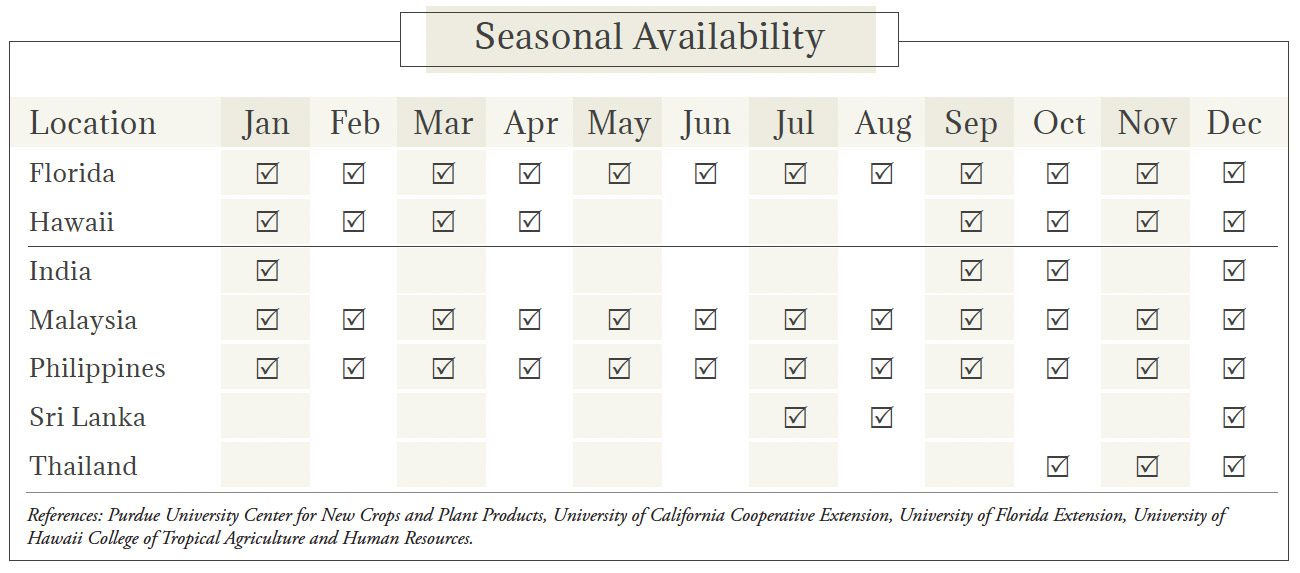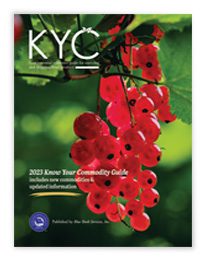Carambola Market Summary


Image: nforfoneShutterstock.com
Carambola Market Overview
Carambola (Averrhoa carambola) is originally from Ceylon and the Molucca Islands (also known as the Spice Islands in Indonesia) and is grown in various countries throughout Southeast Asia and to a lesser extent in the United States.
The unusually shaped fruit, with its distinctive ridges or wings, has become better known by its more descriptive name—star fruit, an obvious choice once sliced in half vertically—but it is also known by many other names such as balimbing, five-finger, kamaranga, kamruk, khe, nak fuang, ma fueang, yang-táo, and zibline.
Although star fruit was introduced to Florida in 1887, the fruit was very tart and used for mostly ornamental purposes until sweeter cultivars arrived from Asia.
Domestically, carambola is grown commercially in Florida and Hawaii, along with smaller producers in California. International growing regions include Australia, Guyana, India, Israel, Malaysia, the Philippines, Sri Lanka, and Taiwan.
Star fruit is usually consumed fresh but can be used as a seasoning or processed into sauces, relishes, jellies, and wines.
Due to high oxalic acid content, those with kidney disease should not consume carambola without consulting a medical professional. Alternatively, in India, carambola is lauded and sought out for its many medicinal purposes.
Types & Varieties of Carambola
Star fruit gets its name from its unique shape when cut, producing five or sometimes six longitudinal ribs or ridges that resemble a star. Flowers are pinkish or lavender with five petals and can be either long or short. There are two primary types of star fruit, one that is smaller and sour and its larger and sweeter sibling. The fruit can vary in color from a golden or light yellow to brighter yellows and oranges. Some varieties, B-10 and B-17, require cross pollination for desirable yields. Arkin, Fwang Tung, and Golden Star do not need cross pollination and are often planted in blocks. Other popular varietals include Hew-1, Hoku, Kajang, Kary, Kwang Tung, Lara, Maha, Newcombe, Sri Kembangan, Thayer, and Wheeler.Cultivation of Carambola
Star fruit trees are well adapted to subtropical and tropical climes and grow slowly, generally reaching 20 to 30 feet in height with a short broad trunk and a bushy rounded canopy. Though mature trees can withstand occasional cold snaps with little damage, temperatures below 27°F will likely kill younger specimens. Carambola trees thrive in rich loam but also grow in sand, clay, and limestone, but do require access to water to maintain moist, well-drained soil. Direct sunlight is another prerequisite, though protection may be needed against drying winds. Fruit will ripen within 60 to 75 days depending on conditions and cultivar. The fruit will generally fade from a bright green to yellow. A mature tree, at least 7 years old, can be expected to produce between 250 to 350 pounds of star fruit per year. Fruit is easily damaged and should be handled with care. As such, star fruit is usually harvested by hand as the exterior color lightens from green to yellow but is not overly ripe. Browning on the wings of the fruit can be a sign of injury and will intensify with moisture loss.


